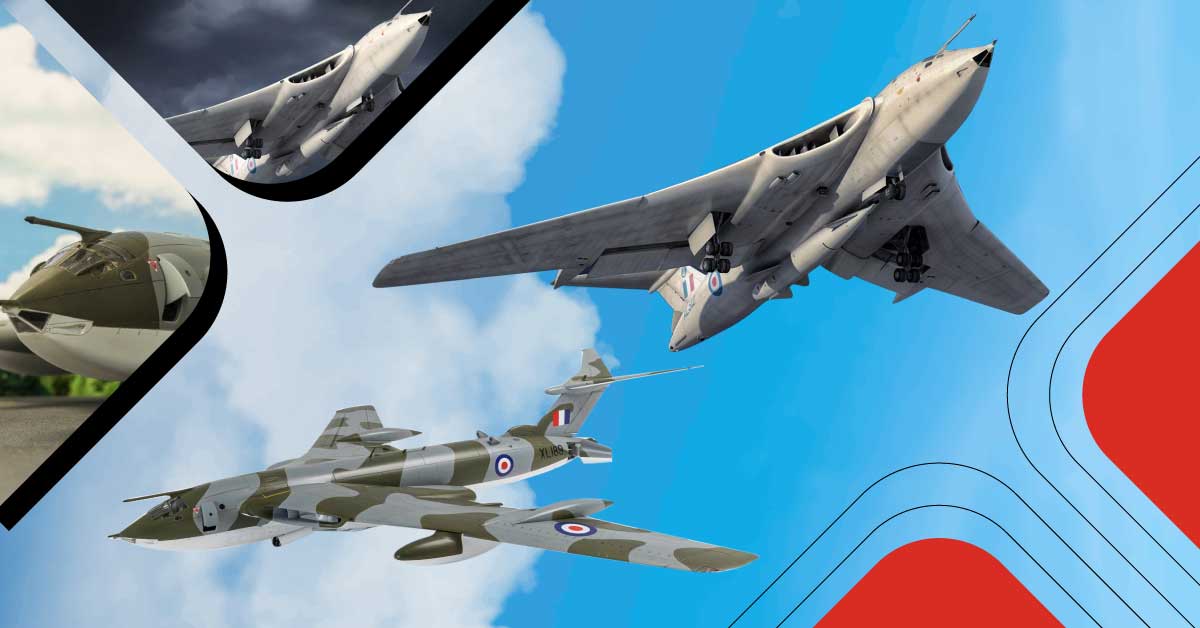Let us have a quick glimpse at what is inside Airfix’s rendition of the Handley Page Victor B.Mk.2 aircraft and check out what this 1/72 scale kit is all about!
Buy it here: Shop now.
Summary
- The History of the Handley Page Victor B.Mk.2
- What is Inside Airfix Handley Page Victor B.Mk.2
- Watch the Unboxing and Kit Review
Background on the Handley Page Victor B.Mk.2
The Handley Page Victor is a long-range strategic bomber developed during the Cold War by the Royal Air Force. It was the third and final aircraft that belonged in the V bomber aircraft unit alongside the Avro Vulcan and the Vickers Valiant, and is known for having one of the strangest aircraft designs you would not find on your typical bomber. It first entered service in 1958 and saw 35 years of illustrious service under the British flag before finally retiring in 1993.
The first HP Victor B.Mk.2 variant was developed in 1959 and was equipped with four powerful Rolls-Royce Conway engines. This upgrade gave the aircraft greater tactical maneuverability and a higher ceiling compared to earlier variants. It was designed for long-range and low-altitude attacks, but after being deemed ineffective as strategic bombers, several were converted for reconnaissance and aerial fueling. Out of the eighty-six HP Victor aircraft ever created, 34 belonged to the B.Mk.2 variant.
What Do You Get?
The HP Victor B.Mk.2 model by Airfix is at 1/72 scale, so you can expect that you are going to end up with a decently sized kit. Despite sharing the same unique engine and wing configurations as the other aircraft in the V-series, the Victor still has a distinct design that makes it such a striking model even at a glance. This plastic model will make that distinctive design with its 228 individual pieces and two camouflage scheme options. Look forward to it!
Fuselage

The fuselage comes in two pieces with nice indented details here and there. It is evident that the model had a lot of improvements in comparison to the first Victor B.2 that was brought out by Airfix. Then we have the parts of the tail with beautiful details, along with the pieces where the engines would sit in the wing routes. The tail on the HP Victor has a distinctive upper-inflicted T-tail at the end for speed. You will also find the struts that help strengthen the fuselage and enable it to hold the weight of the wings.
The other half of the fuselage can be found with the air brakes, bulkheads, and instrumentation on the second sprue. The instrumentation has spectacular details, including its dials, buttons, and other small details that would be a lot of fun to bring out.
Wings
Sprue A

The top portion of the Victor's wings, which would fit behind the cockpit, as well as the portion where the engine would be located, can both be seen here. The underside where the landing gear would be, along with other parts of the wing and the fuselage area, are also contained on this sprue. With just this, you can already tell that it would be a gorgeous kit.
Sprue B

Then, we have more parts of the wings here: the top side and the underside, along with an additional fuel tank and the cockpit. The sensory parts on the wing surfaces are lovely, and all the parts that are popping out make it seem even more realistic.
Weapons Payload

For the weapon payload, we have the immensely powerful British Blue Steel (BS) missile that will be recessed at the belly of the aircraft and the control fins that would go near the front. As for the missile, you will really only need one; as to why, you will know soon enough.
The Blue Steel missile weighed 17,000 pounds with a maximum speed of Mach 3 and a range of 925 kilometers. It was designed as a stand-off missile and has a total potency of 1.1 megatons; to put that into perspective, it is 73 times more powerful than the bomb dropped on Hiroshima, Japan. It is an absolute beast of a warhead and a terrifying unit, especially if you happen to be on the receiving end.
Landing Gear

Because the HP Victor is such a large plane, it has a staggering amount of wheels. On this sprue, we can see the landing gear and the exhaust parts for the engine. The sprue joints are quite thick, so you do have a bit of polishing to do, but it is nothing that a decent pair of side cutters and sanding cannot fix. Then, we also have the seat for the crew, the access ports, and more air intakes to power up all the internal workings of the aircraft.
Instructions

Here we have a typical Airfix manual with basic instructions that are simple and easy to follow. For each part, the pieces that you are supposed to be working with are highlighted with colors so it is easier to understand.
AIRFIX Handley Page Victor B.Mk.2 Color Schemes
Handley Page Victor B.Mk.2 (BS) No.139 Squadron, Royal Air Force Wittering, England (1963-1964)

Handley Page Victor B.Mk.2(BS) Victor Training Flight, Royal Air Force Wittering, England (1968)

Final Thoughts
The Airfix Handley Page Victor B.Mk.2 at 1/72 scale is a really cool kit with splendid details. It is an absolutely beautiful aircraft, so if you are moving up to bombers and you want to do a larger one, this might just be the plane for you! Grab it while you can!
Watch The Unboxing and Review
Watch as Dan unboxes and shows you everything inside the Airfix: Handley Page Victor B.Mk.2 kit.
What do you want us to unbox next? Feel free to message us with your ideas!
Also, make sure to follow us on Facebook, Instagram, Twitter, and Twitch!
 is here! Shop now, pay later in 4 easy installments
is here! Shop now, pay later in 4 easy installments

